David Stairs
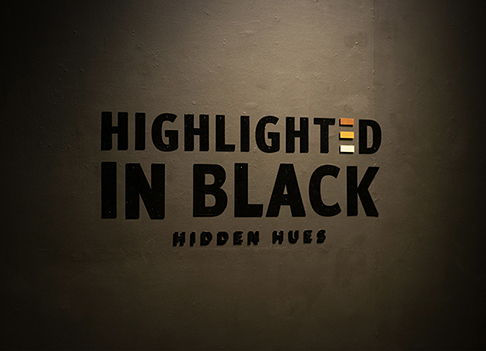
Every three years I am tasked with guiding a group of senior design students through their capstone year. Once upon a time it was enough to mount a student’s portfolio for public exhibition, and this process can still be seen at end-of-year design exhibitions across the country. Design being a supposedly “problem solving” discipline, students are often coached to take on a design problem to research and develop or expand upon. Such projects address topics large and small, ranging from homeless shelters to user experience apps, and everything in between.
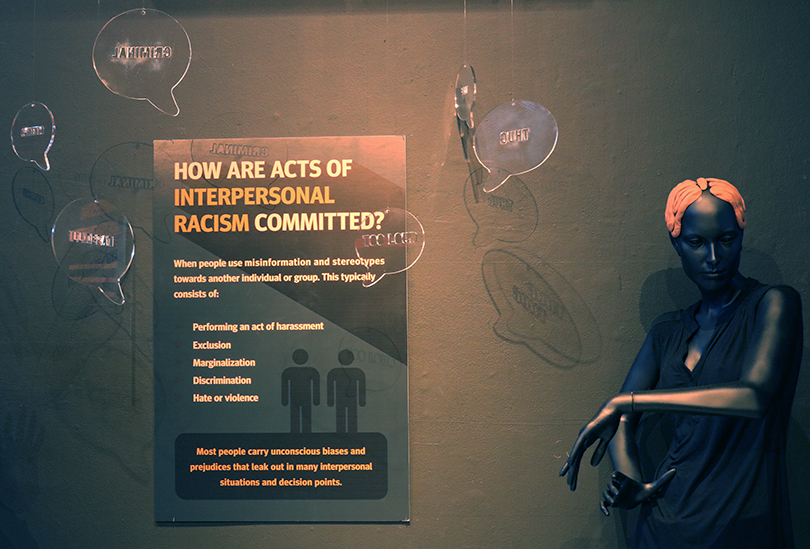
Examples of microaggressions in interpersonal relations. Courtesy of Brianna Byers and Ayanna Wyatt.
A favorite cliché of design pedagogues is to instruct their students to “define a problem” before attempting to redress it. But some problems are so deep-seated, so buried in the darkest recesses of human nature that they resist simple or direct attempts to solve them. It is to these “unsolvable” problems I often direct my students’ collective attention.

A map of neighborhood redlining practices in Detroit by Kendall Murrell
Four years ago I asked my last senior group to consider doing a deep dive into the American prison industrial complex. That result, an exhibition entitled In the System, I wrote about at the time. Starting in April 2020, in the midst of the first Covid lockdown, I began urging my 2021 graduating class to start thinking about what topic they wanted to research. With a group that was 90% female, in the wake of the Me Too movement, I suggested they might want to consider a women’s issues theme. Then, in late May, George Floyd was murdered and they decided they wanted to focus on racism in America.
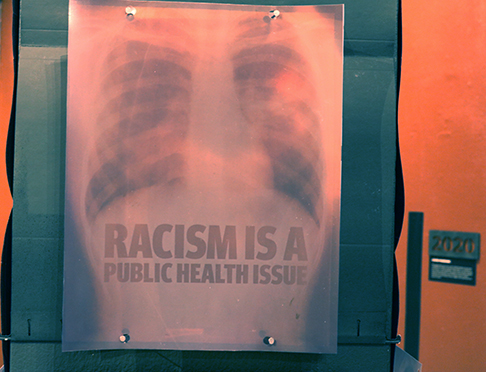 X-ray film representing racism and healthcare by Lydia Hershauer and Cassandra Pokora
X-ray film representing racism and healthcare by Lydia Hershauer and Cassandra Pokora
Racism is such a fraught issue, I suspected it would be a difficult topic. But I am always up for a challenge so, upon returning for the 2020-2021 school year in August we launched into an in depth research project. Dividing the topic into a number of sub-areas, the students formed groups and began to cull the literature on structural, interpersonal, medical, educational, and technological forms of racism. They read books, visited websites, watched films, and tracked down journal articles. The two African American students in the class shared their experiences of growing up black in America.
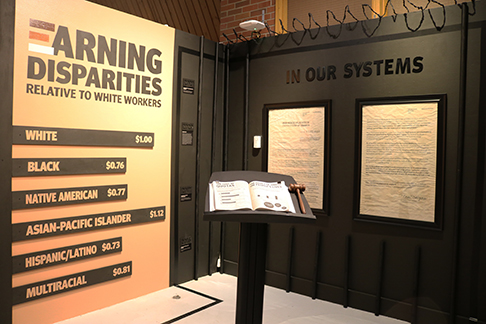
The legal and justice systems in America are tilted against minorities. Work by Madison Skop, Sarah Heck, and Abigail Palmateer
In October we experienced our own small racial crisis. One member of the class was outed for a blackface Halloween prank committed a few years ago. This lapse of maturity did not make a racist of him, but it resulted in disappointment, mistrust and group online behavior that could only be called “bullying.” The perpetrator apologized, to no avail. The group’s anger was such that the event nearly derailed the entire project. After finding an alternate research course for the guilty student, the class attempted to reform and press on.
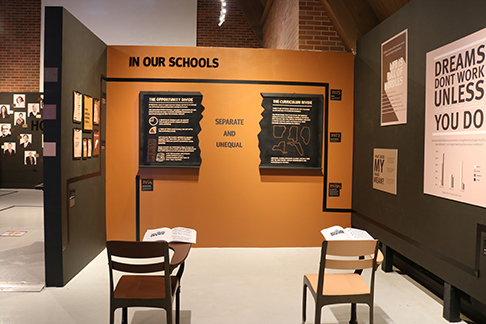
A divide has long existed between white students and minoritiy students in the American educational system. Work by Sydney Belz and Anah Schloegel.
In January 2021 we “returned” from the holiday break, although this is a euphemism as we’d been meeting remotely all year. An online brainstorming session resulted in a name for our project. As the project progressed, the class met with the campus gallery director to get her input. A walk-through the gallery served to inform the students of the space they’d need to fill. At this point it became obvious that some class members wanted to repaint the entire gallery interior black. The gallery director stated that, given the time limitations for installation and deinstallation, painting broadly with a color that would require at least two coats going on and off was impractical.
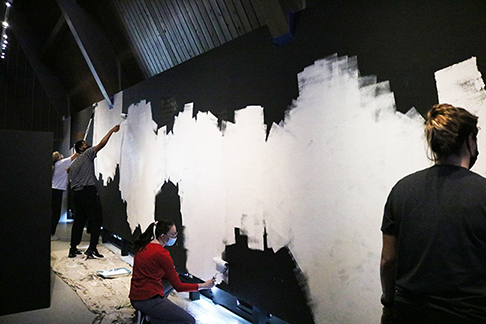
Two coats black followed by two coats white; painting and repainting an entire gallery
During February and into March student groups had formed to try to translate their earlier research into compelling visual presentations of the various types of racism. In addition to the original categories, it was decided that one group would focus on the problem of colorblindness while another would emphasize some of the accomplishments of minority Americans. The colorblind section would experiment with fluctuating red and white LEDs to underscore the issue of Missing and Murdered Indigenous Women in an actual demonstration of optical colorblindness.
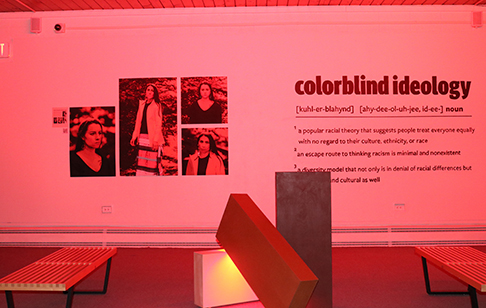
The use of filtered light to demonstrate racial colorblindness. Courtesy Micki Drumm and Madison Skop.
By March 17th students had occupied one part of the gallery. Over the following three weeks eight separate installations as well as a 400-year timeline of racial events in America would develop. As it turned out, one student persuaded the class that an all-black gallery was not only doable, but absolutely necessary, and over 25 gallons of black and white paint was eventually spilled to paint and repaint the gallery walls.
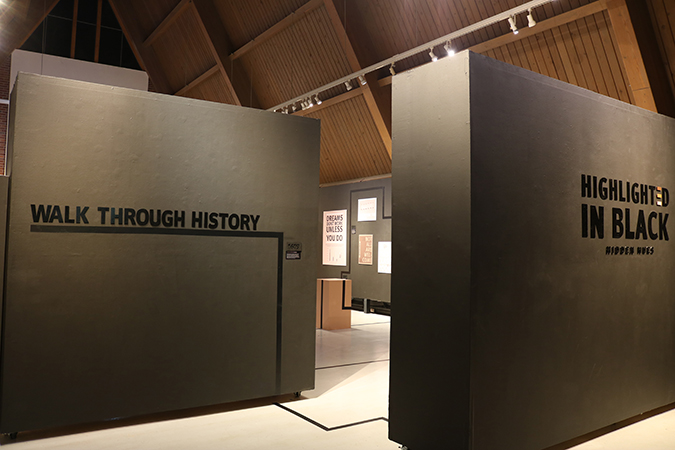
The beginning of a 400-year racial timeline documenting 45 salient racial events in American history
The exhibition Highlighted in Black:Hidden Hues opened on April 6th 2021 to modest response. Covid restrictions had cut into in-person gallery attendance all year, reducing it by nearly 50%. On April 13th, our public relations day, local media visited the show. Starting at 5:45 am, the regional affiliate for both Fox and CBS uplinked a live broadcast from the gallery every 30 minutes for three hours. Eight students from the class made their television debuts, describing for the viewing audience the processes behind their year-long research project. By week’s end, visitors were lined up out the front door of the gallery.
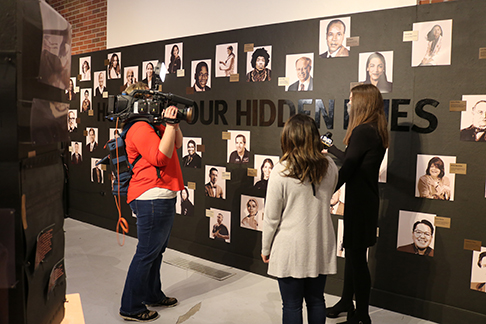
Early morning live TV interview with student Ellyn Yost.
Campus administrators were ecstatic about the press. But in a classic demonstration of “colorblindness” the Facebook page of the television 9&10 News Michigan This Morning program blew up with criticisms from viewers, northern Michigan being a very conservative place. Most of the students took this in stride, but some tried to respond to their critics, a largely unfulfilling task.

Research suggests that Large Learning data sets transmit existing biases into encoded systems like facial recognition software. Courtesy of Joyce Smolinski and Lydia Hershauer.
In the aftermath, the students made a slide presentation to an appreciative Garland Kirkpatrick, their outside design evaluator and critic. They had learned how to define, research, brand, design, and install a museum quality gallery exhibition. And there was even a published process book as a physical document and proof of research.
 A red LED sign asks a pertinent question. Courtesy of Madison Skop.
A red LED sign asks a pertinent question. Courtesy of Madison Skop.
At my institution there has seldom been a visual research project as comprehensive. It had been the group’s sworn goal to surpass the In the System show. Some gallery visitors went so far as to call it “the best exhibition in the university’s history.” I prefer to think of it as an example of what can be accomplished when design education is applied to society’s troubles. Design should not be limited to addressing immediately solvable problems, but to underline and emphasize a research agenda for society, and to educate the public about the things that collectively we need to do better. In this way, as they do through laws and legislation, Americans grow, mature, and hopefully, evolve as a people.
David Stairs is the founding editor of the Design-Altruism-Project.










